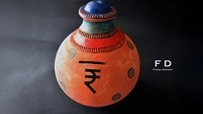A Study on the Evolution of Fixed Deposit Schemes in India
February 20, 2025

Fixed Deposits have always been a popular investment option in India. They offer a safe and secure way to grow your savings while earning a fixed interest rate. But have you ever wondered how these schemes have evolved over the years? In this article, we will explore the historical and modern trends in fixed deposit schemes, providing you with valuable insights to make informed financial decisions.
Evolution of Fixed Deposit Schemes: A Timeline
Fixed deposits have been a staple of banking for many decades, with origins tracing back to the early 20th century.
1980s-1990s: Economic Liberalisation
The Indian economy was liberalised in the 1990s, which led to important changes in the banking sector. Banks began to offer more competitive interest rates on FDs to attract deposits. This period also saw the introduction of various types of fixed deposits, including cumulative and non-cumulative options, catering to different investor needs.
Introduction of Deposit Insurance
In India, the establishment of the Deposit Insurance and Credit Guarantee Corporation (DICGC) in 1978 provided a safety net for depositors. This insurance today covers deposits up to ₹5 lakh, enhancing the attractiveness of FDs as a safe investment option.
Interest Rate Deregulation on FDs in 1990s
The deregulation of interest rates on FDs in the 1990s allowed banks to set their own rates, leading to increased competition. This resulted in higher returns for depositors, making FDs more appealing compared to traditional savings accounts.
Interest Rate Deregulation on Savings Accounts in 2011
The deregulation of savings interest rates in India occurred on October 25, 2011, when the Reserve Bank of India (RBI) allowed banks to set their own interest rates on savings accounts.
Technological Advancements since 2000s
1. Online Banking
The rise of digital banking in the 2000s transformed how customers interacted with banks. Opening and managing FDs became more accessible through online platforms, allowing for easier comparison of interest rates and terms across different banks.
2. Innovative Products
Banks began to introduce innovative FD products, such as:
- Tax-Saver FDs: These FDs provide tax benefits under Section 80C of the Income Tax Act, encouraging long-term savings.
- Flexi FDs: Combining features of savings and fixed deposits, these allow for partial withdrawals while still earning interest.
Modern FD Trends: Digitalisation and Customisation
In recent years, fixed deposit schemes have witnessed significant changes driven by digitalisation and customer demand for more customization. Here are some key modern FD trends:
- Online Account Opening: With the advent of digital banking, it has become easier than ever to open a fixed deposit account online. This convenience allows individuals to save time and effort by avoiding branch visits.
- Customised Interest Payment Options: Banks now offer various interest payment options to suit individual preferences. This means individual customers can decide to receive interest payouts annually, monthly or quarterly.
- Special FD Schemes: To cater to specific financial goals or requirements, banks have started offering special fixed deposit schemes. For example, senior citizens can avail higher interest rates with senior citizen FDs.
- Flexibility in Premature Withdrawals: In the past, premature withdrawals from fixed deposits were penalised heavily. However, many banks now offer more flexibility in terms of premature withdrawal penalties. This allows individuals to access their funds in case of emergencies without incurring substantial losses.
Historical FD Trends for Interest Rates in India
The historical trend of fixed deposit (FD) in India has experienced significant fluctuations influenced by various economic factors, including inflation, monetary policy, and global economic conditions.
Year | Trends |
| Early 2000s | Historical FD trends suggest FD rates were relatively high, ranging from 8.50% to 10.50% in 2000. Rates began to decline gradually, with averages around 7.50% to 8.50% by 2002. |
| Mid to Late 2000s | Interest rates saw a resurgence, peaking around 8.25% to 9.00% in 2008, largely due to economic growth and rising inflation. |
| 2010-2012 | The rates fluctuated between 6.00% and 9.50%, reflecting the Reserve Bank of India's (RBI) monetary policy adjustments aimed at controlling inflation. The highest rates were around 8.50% to 9.25% in 2012. |
| 2013-2015 | The RBI's focus on inflation control led to a decline in FD rates, which fell to 7.00% to 7.50% by 2015. |
| 2016-2019 | The rates continued to decrease, reaching 6.25% to 7.50% by 2019. During this period we saw a stable economic environment and low inflation rates. |
| 2020 | The onset of the COVID-19 pandemic prompted the RBI to cut rates further to stimulate the economy, leading to FD rates dropping to around 5.70% to 6.70%. |
| 2021 | FD rates hit a low of 4.90% to 6.50% as the RBI maintained a low-interest-rate environment to support economic recovery. |
| 2022-2023 | The rates continued to decrease, reaching 6.25% to around 8% by 2019. During this period we saw a stable economic environment and low inflation rates. |
| 2024 | Current Trends: As of 2024, FD interest rates are reported to be higher in the range of 6.50% to 8.25%, reflecting ongoing economic adjustments and the RBI's focus on inflation control and growth stabilisation. |
Please note: The table above gives you a broad indication of historical FD trends and not precise rates. During a particular period, interest rates between banks itself on FD rates can vary substantially.
Final Thoughts
The evolution of fixed deposit schemes over the decades has brought about significant changes in terms of interest rates, tenures, and customisation options. While historical trends show a decline in interest rates, modern FD trends offer convenience and flexibility through digitalisation and personalised features.
Looking to grow your savings? Ujjivan SFB offers a wide range of fixed deposit products. Select the FD of your choice and take a step forward to your financial goals. Alternatively, you can browse through Ujjivan SFB product suite - our wide range of financial products are designed to make your financial life better.
Disclaimer:
The contents herein are only for informational purposes and generic in nature. The content does not amount to an offer, invitation or solicitation of any kind to buy or sell, and are not intended to create any legal rights or obligations. This information is subject to updation, completion, amendment and verification without notice. The contents herein are also subject to other product-specific terms and conditions, as well as any applicable third-party terms and conditions, for which Ujjivan Small Finance Bank assumes no responsibility or liability.
Nothing contained herein is intended to constitute financial, investment, legal, tax, or any other professional advice or opinion. Please obtain professional advice before making investment or any other decisions. Any investment decisions that may be made by the you shall be at your own sole discretion, independent analysis and evaluation of the risks involved. The use of any information set out in this document is entirely at the user’s own risk. Ujjivan Small Finance Bank Limited makes no representation or warranty, express or implied, as to the accuracy and completeness for any information herein. The Bank disclaims any and all liability for any loss or damage (direct, indirect, consequential, or otherwise) incurred by you due to use of or due to investment, product application decisions made by you on the basis of the contents herein. While the information is prepared in good faith from sources deemed reliable (including public sources), the Bank disclaims any liability with respect to accuracy of information or any error or omission or any loss or damage incurred by anyone in reliance on the contents herein, in any manner whatsoever.
To know more about Ujjivan Small Finance Bank Products Visit:"https://www.ujjivansfb.in"
All intellectual property rights, including copyrights, trademarks, and other proprietary rights, pertaining to the content and materials displayed herein, belong
to Ujjivan Small Finance Bank Limited or its licensors. Unauthorised use or misuse of any intellectual property, or other content displayed herein is strictly prohibited and the same is not intended for distribution to, or use by, any person in any jurisdiction where such distribution or use would (by reason of that person’s nationality, residence or otherwise) be contrary to law or registration or would subject Ujjivan Small Finance Bank Limited or its affiliates to any licensing or registration requirements.
FAQs
1. In what way has the evolution of fixed deposit schemes taken place in India?
The evolution of fixed deposit schemes in India has taken place through interest rates, digitisation and introduction of tax savings deposits in 2006.
2. Why is it important to study historical FD trends?
Studying historical FD trends, may throw some light on interest rates movement, though it is unlikely to change anything.
3. What are the benefits of customised interest payment options?
4. Are there any special fixed deposit schemes?
Yes, banks offer special fixed deposit schemes to cater to specific needs. For example, senior citizens can avail higher interest rates with senior citizen FDs. Another example would be Ujjivan SFB's Platina Fixed Deposit, a non-callable premium FD scheme offering higher returns.
5. Can I open a fixed deposit account online?
Yes, most banks now offer the option to open a fixed deposit account online. This allows you to save time and effort by avoiding branch visits.
6. Are senior citizens eligible for higher interest rates on fixed deposits?
Yes, many banks offer higher interest rates to senior citizens as a special benefit. These rates are generally 0.25% to 0.5% higher than the rates offered to regular investors.
7. Can I choose a nominee for my fixed deposit account?
Yes, you can nominate an individual to receive the benefits of your fixed deposit account in case of your unfortunate demise.
8. What happens if I miss renewing my fixed deposit after maturity?
If you miss renewing your fixed deposit after maturity, the bank may either transfer the funds to a savings account or renew the fixed deposit automatically for a similar tenure with prevailing interest rates.
Latest Blogs

ITR-1 (Sahaj) Restrictions: Income Sources Not Allowed & Filing Rules
With just a few days left before the 15 September 2025 deadline for filing Income Tax Returns (ITRs) for Assessment Year (AY) 2025-26, many taxpayers are rushing to submit their forms online.

GST Rate Cut on Electronics: What It Means for Consumers and Retailers
India’s Goods and Services Tax (GST) system has entered a new era with the rollout of GST 2.0, effective from September 22, 2025.

Banking Safety Guide: How to Avoid QR Code Frauds While Making Payments
India’s love for QR code payments has made transactions lightning-fast, but also opened a new front for cybercriminals.

Scam Alert! Phishing, Vishing, and Smishing Can Drain Out Your Finances
Digital banking in India has transformed the way we manage money.

India’s New GST Reform Bill: What GST 2.0 Means for You
India’s indirect tax system is entering a landmark new phase.





